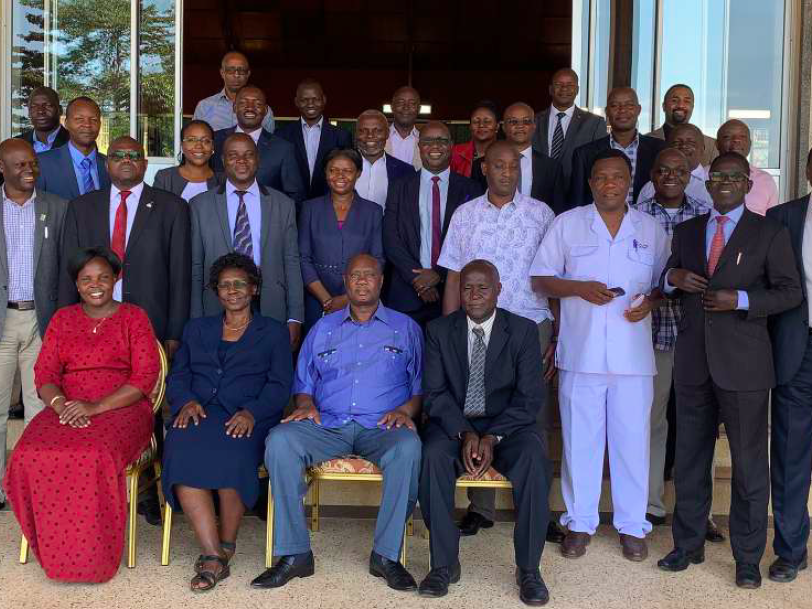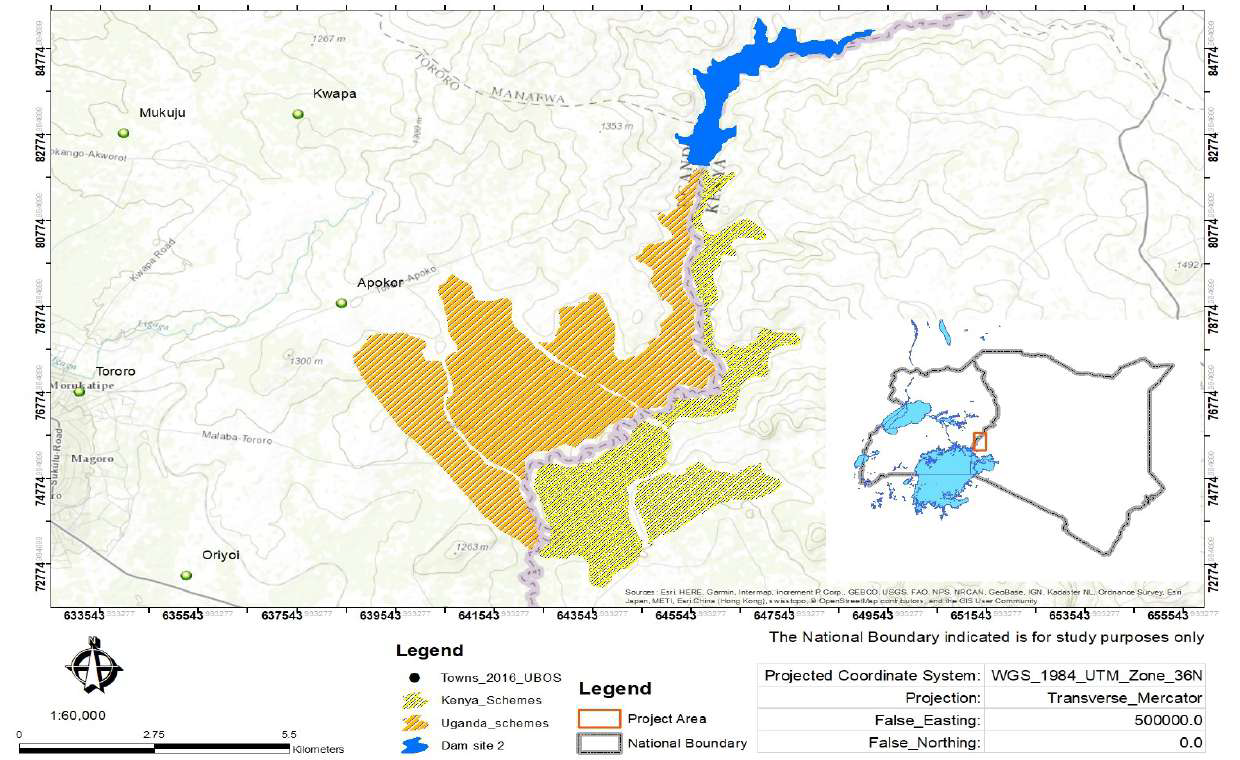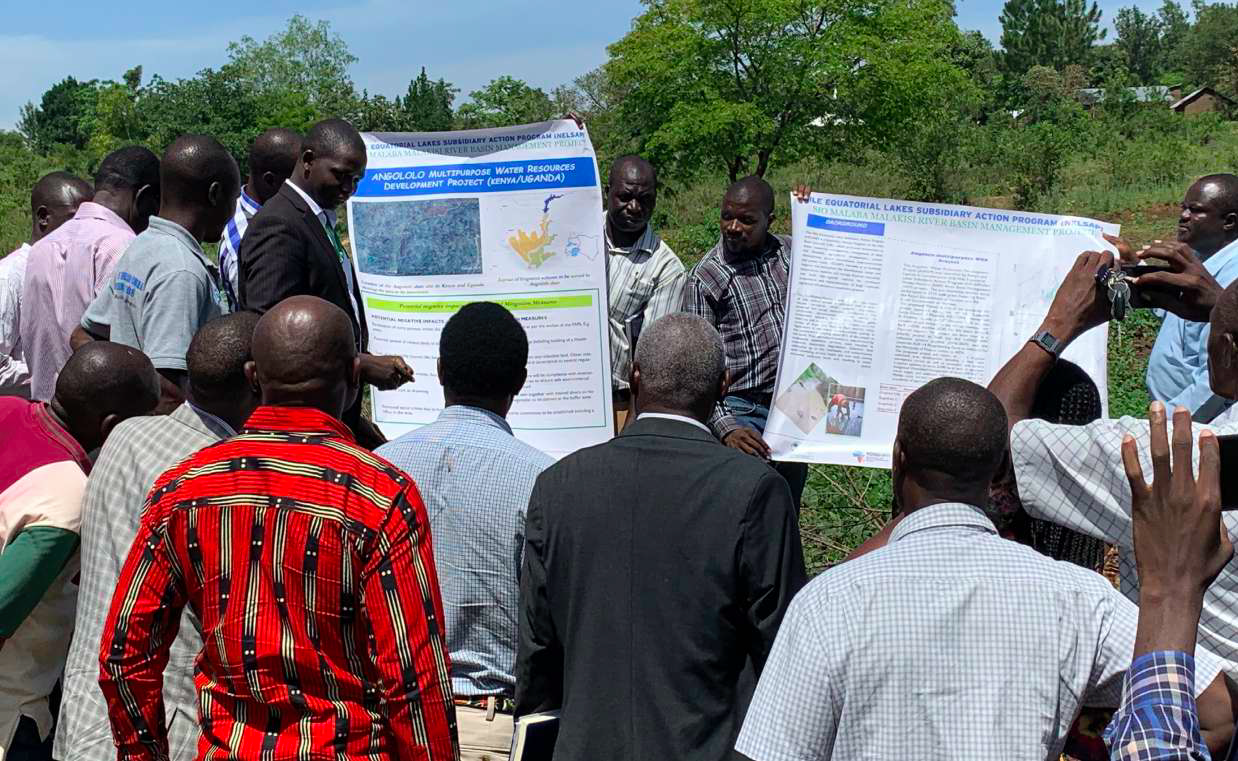
The Angololo Water Resources Development Project (AWDP) is located on the trans-boundary Malaba River that is between Kenya and Uganda and it falls within the Sio-Malaba Malakisi (SMM) River Basin within the Lake Victoria sub basin.
The project consists of a proposed 30 metre high dam with a reservoir capacity of 43.0 million cubic metres that will supply potable water to 20,000 people and irrigate 3,300 hectares (1,180 Ha in Kenya and 2,120 Ha in Uganda). The dam will generate 1.75MW hydropower. The project has a catchment area of 430 kilometres squared. In total the Angololo Water Resources Development Project is expected to benefit at least 127,300 people from Tororo, Manafwa, and Namisindwa districts in Eastern Uganda and Busia and Bungoma Counties in Kenya through employment creation, irrigated agriculture, piped water supply, hydropower generation, and livestock and fisheries production.
The Angololo project was identified by Kenya and Uganda in collaboration with Nile Equatorial Lakes Subsidiary Action Program (NELSAP) through its Sio Malaba Malakisi (SMM) River Basin Management (RBM) project. NELSAP-CU conducted its prefeasibility studies in 2010 with grant financing from the Royal Government of Sweden and the Royal Government of Norway. Following this identification study, the Governments of Kenya and Uganda formally requested NELSAP to integrate it into its pipeline of natural resources projects for further appraising and development.
The project was approved during the 18th Nile Equatorial Lakes Council of Ministers (NELCOM) meeting held in Entebbe, Uganda on 13th October 2015 and was included into the African Development Bank (AfDB) pipeline (IOP) for the year 2016 – 18 to seek possible funding support. NELSAP-CU/NBI was mandated in the signed MOU between Uganda and Kenya to support in mobilization of resources for preparation of the investment project. NELSAPCU approached AfDB Eastern Africa Regional Centre (EARC) for funding to undertake preparation studies.
The project has been rated as a priority project in both the AU NEPAD IPPF indicative project pipeline (2016-2020) and the countries ADF-14 Programming Cycle.
NELSAP-CU is now undertaking preparatory work. This involves a full feasibility study, conceptual and detailed designs, preparing tender documents, conducting social and environmental impact assessment (ESIA) developing a resettlement and compensation action plan (RCAP) and project implementation preparation, in order to secure the financing required to implement the project.
This phase of the project will be implemented over a duration of 24 months and it will enhance cooperation between Kenya and Uganda as they jointly develop water resources of Malaba River.
Project Study Objectives
The objectives of the proposed Angololo project studies are to assess the potential and viability for multipurpose water resources development in irrigated agriculture, hydropower generation, livestock development, water supply, flood control, drought mitigation, aquaculture, etc., coupled with restoration of the associated sub-catchments.
Main Project components
The project studies will consist of the following components:
- Feasibility Study, Detailed Design and Preparation of Tender Documents;
- Independent Environmental and Social Impact Assessment (ESIA) and Resettlement Action Plan (RAP)
- Stakeholder engagements to validate project study outputs.
Once proven economically viable, the project studies will proceed to detailed designs, and preparation of tender documents.
Angololo Project Study Outputs
The expected Angololo project study outputs are:
- Technical feasibility study, detailed designs, and economic viability of the project including implementation arrangements and schedules, and tender documents;
- Detailed Environmental and Social Impact Assessment (ESIA);
- Environmental and Social Management Plan (ESMP)
- Resettlement and Compensation Action Plan (RCAP);
- Watershed Management Plan;
- Stakeholders meetings; and
- Dam Operation & Maintenance (O&M) Plan
- Dam Instrumentation Plan
- Emergency Preparedness Plan

The objective of the AWDP is to alleviate poverty in the project area by transforming the existing subsistence farming into large-scale commercial farming of irrigated lands producing principally high value horticultural crops. Increase adaptation to climate change, reverse environmental degration, improve water supply and sanitation, strengthen transboundary cooperation, promote agro-processing and crop and livestock production.
The objectives of the Angololo Project are in line with Government of Uganda and Government of Kenya policies and enhance efforts towards poverty reduction; institutional development and capacity strengthening; gender equality; economic, social, political, and cultural rights. The Angololo Project design has been holistic with agricultural livestock water use factored into the general approach.
On 17th July 2019, NELSAP-CU together with representatives of Kenya and Uganda officially launched the feasibility phase of the USD 1.65 million Angololo Project that is being funded by the African Development Bank AfDB (USD 1.5 million) and the Republics of Kenya and Uganda (each USD 75,000). The project was officially launched by the Governor of Busia, Kenya Hon. Sospeter Ojaamong and the Director of Water Resources of Uganda, Dr Florence Adongo, who was representing the Hon. Uganda Minister for Water and Environment. The launch was held in Entebbe, Uganda.
The project conducted community sensitisation and awareness meetings in March 2020 on both sides of the border. Its Objectives were;
- To create awareness among the wider community members about the project.
- To explain to the community the scope of the envisaged project feasibility studies.
- To solicit for community support and goodwill towards the project study activities. Stakeholders who participated in this community sensitisation and awareness were; political, administrative, and technical persons from Busia County Kenya and Tororo district in Uganda. It also included representatives from the Ministries of Water and Finance from Kenya and Uganda.
In March 2020 the process of creating the independent International Dam Safety Panel of Experts (DSPoE) was completed.
The panel consists of key experts in hydrology, geology and dam design and construction engineering. The panel will review and advise NELSAP on matters related to dam safety and other critical aspects of the dam like dam structures, catchment area, reservoir, power facilities, dam filling up and river diversion among others.

Kenya and Uganda have formed a Regional Project Steering Committee (RPSC) that is composed of representatives of the permanent/principal secretaries of the ministries responsible for water, irrigation, agriculture and finance in both countries.
The RPSC is providing supervisory, advisory and strategic guidance to this full feasibility phase of the project. The RPSC is in charge of approving project work plans, approving budgets, approving procurement plans and is providing a linkage with the relevant national institutions to ensure counterpart support to the project. The RPSC is also responsible for facilitating joint agreements, linkages and reporting back to the parent ministries.
The RPSC is coordinating the implementation of the Angololo project and its prioritisation in the participating countries’ National Development Plans (NDPs).
The Director of Trans-boundary Water Resources of Kenya Ms. Gladys Wekesa is leading the Kenyan representation to the Steering Committee while the Uganda side is led by Mr. Jackson Twinomujuni, the Commissioner for International and Trans-boundary Water Affairs of Uganda. RPSC has a rotational Chair alternating between the permanent/principal secretaries of the two countries on an annual basis.
The Nile Equatorial Lakes Subsidiary Action Programme Coordination Unit (NELSAP-CU) headquartered in Kigali, Rwanda, is one of the two investment programmes of the Nile Basin Initiative (NBI), the other being the Eastern Nile Subsidiary Action Programme (ENSAP) headquartered in Addis Ababa, Ethiopia known as Eastern Nile Technical Regional Office (ENTRO). NELSAP-CU was established in December 1999 by the Council of Ministers for Water Affairs in the Nile River Basin, with a mission to “contribute to the eradication of poverty, promote economic growth, and reverse environmental degradation in the Nile Equatorial Lakes (NEL) region, within the overall NBI’s shared Vision of sustainable socioeconomic development and the equitable use of and benefit from Nile Basin water resources”. NELSAP-CU is governed and reports to the Council of Water Ministers from 10 Nile Basin membership states of Burundi, DR Congo, Egypt, Ethiopia, Kenya, Rwanda, South Sudan, Sudan, Tanzania and Uganda.
Time Schedule for Implementation - 24 months
Budget
US Dollars 1,650,000 including 1,500,000 from the African Development Bank (AfDB) NEPADIPPF Grant and 75,000 Country Contributions from the Governments of Kenya and Uganda.
